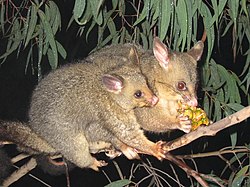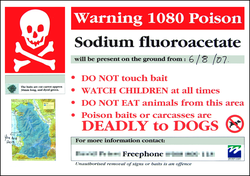Sodium monofluoroacetate
Sodium fluoroacetate is a chemical compound that is a poison for many organisms. Pesticides used kill rodents sometimes contain Sodium monofluoroacetate. Sometimes the chemical substance is used as a marker for cancer cells in Positron emission tomography. TO act as a marker, only very small quantities of a substance are needed. For this reason, the toxicity of Sodium fluoroacetate is not a problem.
Fluoroacetate occurs naturally in at least 40 plants in Australia, Brazil, and Africa. It was first identified in the poison leaf (gifblaar) Dichapetalum cymosum by Marais in 1944.[1][2] As early as 1904, colonists in Sierra Leone used extracts of Chailletia toxicaria which also contains fluoroacetic acid or its salts to poison rats.[3][4][5] Several native Australian plant genera contain the toxin, including: Gastrolobium, Gompholobium, Oxylobium, Nemcia and Acacia.
Sodium Monofluoroacetate Media
References
- ↑ Marais, J. C. S. (1943). "The isolation of the toxic principle "K cymonate" from "Gifblaar", Dichapetalum cymosum". Onderstepoort Journal of Veterinary Science and Animal Industry. 18: 203.
- ↑ Marais, J. C. S. (1944). "Monofluoroacetic acid, the toxic principle of "gifblaar" Dichapetalum cymosum". Onderstepoort Journal of Veterinary Science and Animal Industry. 20: 67.
- ↑ Renner (1904). "Chemical and Physiological Examination of the Fruit of Chailletia Toxicaria". Jour African Soc.: 109.
- ↑ Power, F. B.; Tutin, F. (1906). "Chemical and Physiological Examination of the Fruit of Chailletia toxicaria". Journal of the American Chemical Society. 28 (9): 1170–1183. doi:10.1021/ja01975a007.
{{cite journal}}: CS1 maint: multiple names: authors list (link) - ↑ Vartiainen, T.; Kauranen, P. (1984). "The determination of traces of fluoroacetic acid by extractive alkylation, pentafluorobenzylation and capillary gas chromatography-mass spectrometry". Analytica Chimica Acta. 157 (1): 91–97. doi:10.1016/S0003-2670(00)83609-0.
{{cite journal}}: CS1 maint: multiple names: authors list (link)



